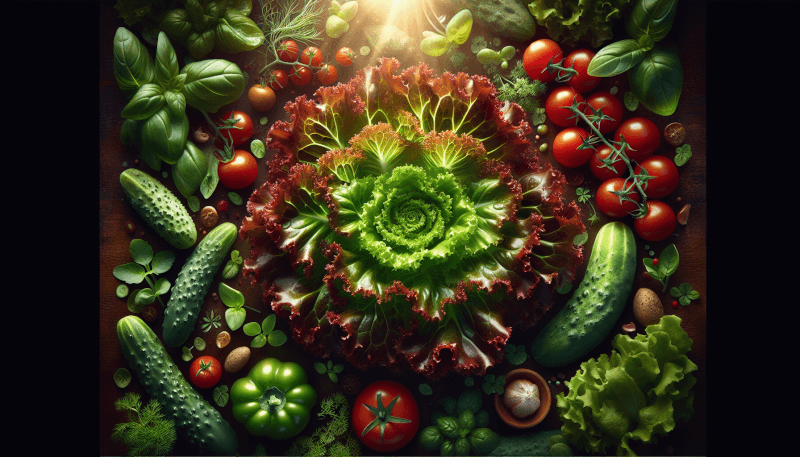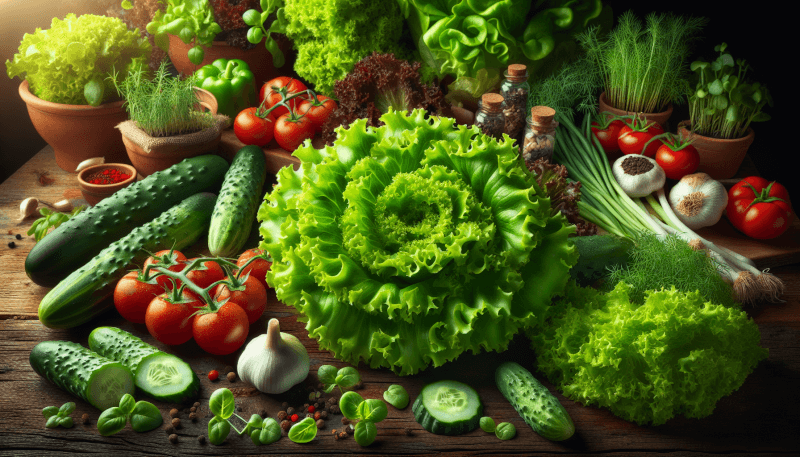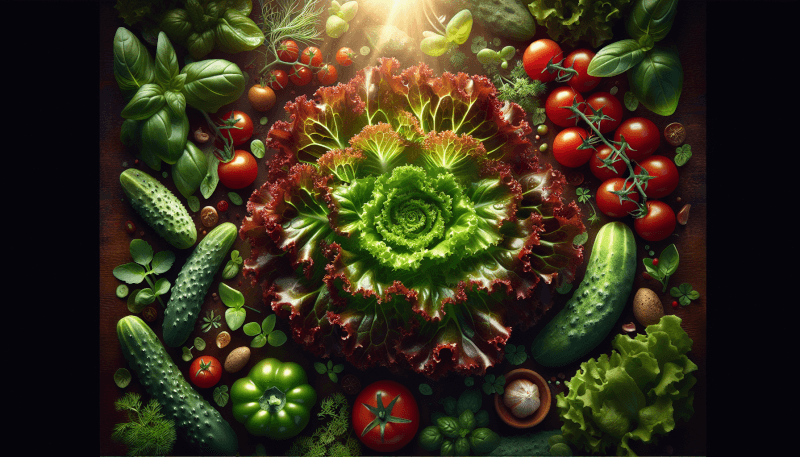Are you tired of constantly running to the grocery store to buy fresh salad ingredients? Look no further! This beginner’s guide will show you just how easy it is to grow your own salad ingredients right in the comfort of your own home. From crisp lettuce leaves to juicy tomatoes and crunchy cucumbers, you’ll be able to enjoy a delicious and healthy salad straight from your own garden. With simple tips and step-by-step instructions, you’ll be a salad-growing expert in no time. Say goodbye to store-bought greens and hello to homegrown goodness!

Choosing the Right Location
When it comes to growing your own salad ingredients, choosing the right location is key. First and foremost, consider the amount of sunlight the area receives. Most salad plants thrive in full sun, which means they need at least 6 hours of direct sunlight each day. Find a spot in your garden that gets plenty of sun throughout the day to ensure the health and vitality of your salad plants.
Another important factor to consider is good drainage. Salad plants do not like to sit in waterlogged soil, so make sure the area you choose has well-draining soil. If you have heavy clay soil, you may need to amend it with organic matter or create raised beds to improve the drainage.
Additionally, take into account the proximity to a water source. Salad plants need regular watering, especially during hot summer days, so having easy access to a water source will make it convenient for you to keep your plants hydrated.
Preparing the Soil
Before planting your salad garden, it’s important to prepare the soil properly to create a fertile environment for your plants to grow. Start by removing any weeds or debris from the area. Weeds compete with your salad plants for nutrients and can hinder their growth, so it’s essential to clear them out.
Next, loosen the soil with a garden fork. This will help improve the aeration and drainage of the soil, allowing the roots of your salad plants to grow freely. Work the fork at least 8 inches deep into the soil, breaking up any clumps or compacted areas.
To further enrich the soil, add organic matter such as compost or aged manure. These natural amendments will provide essential nutrients to your plants and improve the overall structure of the soil. Spread a layer of compost or aged manure over the area and mix it into the soil using a garden fork or a tiller.

Selecting Salad Plants
Now that you have prepared the soil, it’s time to choose the salad plants you want to grow. Here are some popular salad plants that are easy to grow and will provide you with delicious ingredients for your salads:
Lettuce: Lettuce is a staple in any salad garden. There are various types available, including loose-leaf, butterhead, and romaine. Choose a variety that suits your taste and climate.
Tomatoes: Tomatoes add a burst of flavor to salads. There are many different varieties to choose from, including cherry tomatoes, beefsteak tomatoes, and heirloom varieties. Consider the size and flavor profile you prefer when selecting tomato plants.
Cucumbers: Cucumbers are refreshing and crunchy, making them a great addition to salads. Look for varieties that are specifically bred for salad production and choose between slicing cucumbers or pickling cucumbers.
Radishes: Radishes add a tasty and peppery crunch to salads. They come in various colors and shapes, so choose the ones that appeal to you. Radishes are also quick to mature, making them ideal for beginner gardeners.
Carrots: Carrots can be enjoyed raw or cooked in salads. They come in different colors and sizes, so pick the ones that suit your preferences. Look for carrot varieties that are bred for sweetness and crispness.
Spinach: Spinach is packed with nutrients and adds a delightful leafy texture to salads. Choose a variety that is resistant to bolting and opt for baby spinach leaves for a milder flavor.
Starting from Seeds
Once you have selected your salad plants, you can start growing them from seeds. Seeds are an affordable and rewarding way to start your salad garden. Here are some tips for starting your plants from seeds:
Read the seed packets for instructions: Each type of seed may have specific instructions for planting depth, spacing, and timing. Take the time to read the seed packets to ensure you’re giving your seeds the best chance of success.
Start seeds indoors or directly in the garden: Some salad plants, like tomatoes and cucumbers, benefit from being started indoors before being transplanted into the garden. Others, like lettuce and radishes, can be directly sown into the garden.
Sow seeds at the appropriate depth: The seed packets will specify the recommended planting depth for each type of seed. Follow these guidelines to ensure optimal germination and growth.
Keep the soil moist until germination: After sowing the seeds, make sure to keep the soil consistently moist until the seeds germinate. Water gently to avoid displacing the seeds, and consider covering the area with a thin layer of mulch to retain moisture.

Caring for Your Salad Garden
To ensure the health and productivity of your salad garden, it’s important to provide ongoing care. Here are some essential tasks to keep in mind:
Watering
Salad plants generally require consistent moisture to thrive. Water your garden regularly, aiming to keep the soil evenly moist. Avoid overwatering, as this can lead to root rot and other issues. Mulching around the plants can help retain moisture in the soil.
Mulching
Mulching is a beneficial practice for a salad garden. Apply a layer of organic mulch, such as straw or wood chips, around the base of your plants. Mulch helps to suppress weeds, retain moisture, and regulate soil temperature, creating a favorable environment for your salad plants.
Fertilizing
To promote healthy growth and abundant harvests, fertilize your salad garden regularly. Organic fertilizers, such as compost or well-rotted manure, are ideal for feeding your plants. Apply the fertilizer according to the package instructions, being careful not to over-fertilize, which can burn the plants.
Pruning and Thinning
Proper pruning and thinning can help maximize the productivity and aesthetics of your salad garden. Remove any yellow or diseased leaves to prevent the spread of pests and diseases. Thin out crowded plants to allow proper air circulation and to prevent competition for nutrients.
Dealing with Pests and Diseases
Like any garden, salad gardens can face challenges from pests and diseases. Here are some tips for dealing with common issues:
Identify common pests and diseases
It’s important to be able to identify common pests and diseases that can affect your salad plants. Aphids, slugs, snails, and fungal diseases like powdery mildew are some of the common problems you may encounter. By familiarizing yourself with the signs and symptoms, you can take appropriate measures to control and prevent infestations.
Use organic pest control methods
Whenever possible, opt for organic pest control methods to protect your salad garden. This can include handpicking pests, using natural predators, such as ladybugs, or applying organic insecticidal soaps or neem oil. Avoid using harsh chemical pesticides, as they can harm beneficial insects and pollinators.
Inspect your plants regularly
Regularly inspecting your plants is crucial for catching pest infestations or diseases early on. By identifying problems early, you can take swift action and prevent the spread of pests or diseases to other plants. Look for signs of damage, discoloration, or unusual growth patterns and address them promptly.

Harvesting Your Salad Ingredients
The most exciting part of growing your own salad ingredients is the bountiful harvest. Here are some guidelines for harvesting common salad plants:
Harvest lettuce leaves when they’re young and tender
Lettuce leaves can be harvested individually as needed or as whole heads. For loose-leaf varieties, simply pick the outer leaves, leaving the inner leaves to continue growing. For head lettuce, wait until the heads are firm and fully formed before harvesting.
Pick tomatoes when they reach full color and firmness
Tomatoes are best when picked at their peak of ripeness. They should be fully colored, firm to the touch, and easily separate from the stem. Avoid picking them too early, as they may lack flavor and not fully develop.
Harvest cucumbers when they’re about 6-8 inches long
Cucumbers are ready to be harvested when they reach a length of about 6-8 inches, depending on the variety. They should be firm, crisp, and have a vibrant color. Regularly harvest cucumbers to encourage more fruit production.
Pull radishes when they’re about the size of a golf ball
Radishes are a quick-growing crop, and they can be harvested when they reach the size of a golf ball. Pull them gently from the ground to avoid damaging the roots. Smaller radishes tend to be milder in flavor, while larger ones may be spicier.
Storing and Enjoying Your Harvest
Once you’ve harvested your salad ingredients, it’s important to properly store them to maintain freshness and flavor. Follow these steps to enjoy the fruits of your labor:
Clean and wash the harvested vegetables
After harvesting, gently clean and wash the vegetables to remove any dirt or residue. Use cool running water and a soft brush if needed. Avoid washing them too far in advance to prevent moisture buildup, which can lead to spoilage.
Store them in the refrigerator
For most salad vegetables, storing them in the refrigerator will help maintain their freshness. Place them in perforated plastic bags or airtight containers to prevent wilting and retain moisture. Some vegetables, like tomatoes and cucumbers, are best stored at room temperature to maintain their flavor and texture.
Use them in salads, sandwiches, or other recipes
Now that you have your freshly harvested salad ingredients, the possibilities are endless. Use them in salads, sandwiches, wraps, or other recipes that showcase their vibrant flavors. Experiment with different combinations and dressings to create delightful meals using your homegrown ingredients.

Extending the Salad Season
If you want to enjoy fresh salads for longer periods throughout the year, there are strategies you can employ to extend the salad season:
Consider growing salad greens in containers or a greenhouse
Growing salad greens in containers allows you to control the growing environment and extend the season. Place containers in a sunny spot and ensure they have good drainage. For even more control over the growing conditions, consider investing in a greenhouse, where you can grow salad greens year-round.
Plant cool-season crops for a fall or winter harvest
Many salad greens, like lettuce and spinach, thrive in cool weather. To extend the salad season into fall or even winter, plant these crops in late summer or early fall. They will continue to grow and provide fresh ingredients even as the weather cools down.
Use row covers or cold frames to protect plants from frost
Row covers and cold frames can provide protection from frost and extend the growing season. These protective barriers can be placed over your salad plants to trap heat and keep them warmer during colder nights. This allows you to continue harvesting fresh salad ingredients even in chilly weather.
Troubleshooting Common Issues
While growing your own salad ingredients can be a rewarding experience, you may encounter a few common issues along the way. Here are some troubleshooting tips for addressing these problems:
Yellowing leaves
Yellowing leaves can be caused by various factors, including nutrient deficiencies, overwatering, or pests. Check the soil moisture levels and adjust your watering accordingly. If the issue persists, consider fertilizing with a balanced organic fertilizer and inspecting for pests.
Bolting lettuce
Lettuce typically bolts and produces a flowering stalk in response to heat or prolonged daylight hours. To prevent bolting, choose heat-tolerant lettuce varieties and consider planting in a partially shaded area during the hottest months. Harvesting lettuce regularly can also help delay bolting.
Fruiting problems in tomatoes
Tomatoes may experience issues with fruit set or fruit dropping prematurely. This can be caused by inconsistent watering, nutrient imbalances, or extreme temperatures. Ensure your plants receive adequate water and nutrients, and provide shade during excessively hot periods.
Mildew on cucumber leaves
Cucumber leaves are prone to powdery mildew, a fungal disease that appears as a white powdery coating on the leaves. To prevent mildew, ensure proper air circulation around the plants by spacing them adequately. Water the soil, not the leaves, and consider applying a natural fungicide if necessary.
By following these guidelines and paying attention to the needs of your salad plants, you’ll be well on your way to a successful and bountiful salad garden. Enjoy the satisfaction of growing your own fresh and delicious ingredients, and savor the taste of your homegrown salads for seasons to come. Happy gardening!


